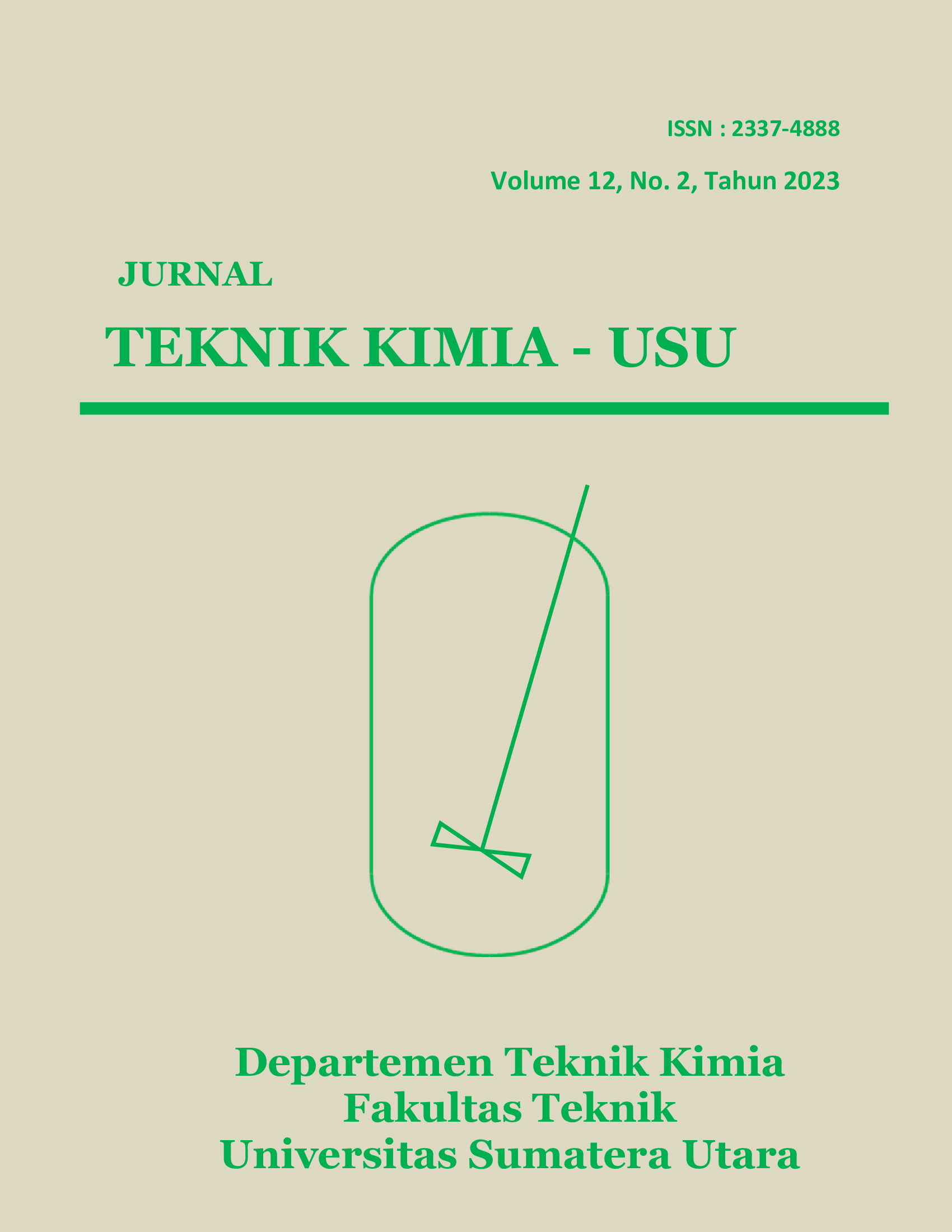Pembuatan Gum Xanthan dengan Proses Fermentasi dari Hidrolisat Selulosa Eceng Gondok dan Penerapannya dalam Enhanced Oil Recovery
DOI:
https://doi.org/10.32734/jtk.v12i2.11574Keywords:
water hyacinth’s cellulose, glucose, fermentation, xanthan gum, enhanced oil recoveryAbstract
Water hyacinth is a freshwater plant that has a negative impact on waters, but has a high cellulose content (77.6%) and is still underutilized. One alternative in controlling the amount of water hyacinth is to utilize its potential cellulose content as an ingredient in xanthan gum. Fermentation was carried out with the help of Xanthomonas campestris and xanthan gum was obtained, which can be used as a polymer injection material to increase crude oil production in the oil refinery industry. The stages to obtain xanthan gum are delignification, hydrolysis, and anaerobic fermentation (28 °C) with a time variation of 24 hours to 120 hours with an interval of 24 hours. The cellulose hydrolysate variable is 0.5%, 1.0%, 1.5%, 2.0%, and 2.5%. The yield of xanthan gum in this research was 18%, with a moisture content was 13% – 15% and an ash content was 3% –3.9%. The resulting xanthan gum was analyzed for its functional groups using Fourier Transform Infra Red (FTIR) and was in agreement with commercial xathan gum.
Downloads
References
E. Kusumawati and Haryadi, “Ekstraksi dan Karakterisasi Serat Selulosa dari Tanaman Eceng Gondok (Eichornia crassipes)â€, Jurnal Fluida, vol. 14, no 1, p. 7, 2021.
J. Pratama, R. Rohmah, A. and T. Saraswatia, “Isolasi Mikroselulosa dari Limbah Eceng Gondok (Eichhornia crassipes) dengan Metode Bleaching-Alkalinasiâ€, Jurnal Penelitian Kimia, vol. 15, no 2, pp. 239-250, 2019.
S. Gustiani, Q. Helmy, C. Kasipah and E. Novarini, “Produksi dan Karakterisasi Gum Xanthan dari Ampas Tahu Sebagai Pengental Pada Proses Tekstilâ€, Arena Tekstil, vol. 32, no 2, pp. 51-58, 2018.
Z. Hasan, A. Yulianto, I. Mulawati and S. Putri, “Produksi Xanthan Gum Skala Pengembangan Menggunakan Limbah Padat Tapiokaâ€, Jurnal Illmiah Teknik Industri, vol. 6, no 2, pp. 97-105, 2018.
M. R. Ansyori, “Mengenal Enhanced Oil Recovery (EOR) Sebagai Solusi Meningkatkan Produksi Minyakâ€, Forum Teknologi, vol. 8, no 2, p. 18, 2018.
Anonim, “Produksi Minyak Bumi di Indonesia Tahun 2015 - 2020â€, Badan Pusat Statistik, 2021.
T. Erfando, N. Rita and R. Ramadhan, “The Key Parameter Effect Analysis Of Polymer Flooding On Oil Recovery Using Reservoir Simulationâ€, Journal of Geoscience, Engineering, Environment, and Technology, vol. 4, no 1, pp. 49 - 55, 2019.
I. Kurniaty, U. Habibah, D. Yustiana and I. Fajriah, “Proses Delignifikasi Menggunakan NaOH dan Amonia (NH3) pada Tempurung Kelapacâ€, Jurnal Integrasi Proses, vol. 6, no 4, p. 198, 2018.
A. A. Mariod, “Gum Arabic: Structure, Properties, Application and Economicsâ€, vol. 1, London: Academic Press, 2018, pp. 175 - 180.
S. Baig, Biosynthesis of xanthan gum by locally isolated Xanthomonas species, University of The Punjab, 1984.
T. J. Pollock, Preparation of Xanthan Gum Using Xanthomonas Campestris Having Lactose Utilization Genes, California: SHIN-ETSU BIO, Inc., 2003.
H. Habibi and K. Khosravi-darani, “Biocatalysis and Agricultural Biotechnologyâ€, vol. 10, Iran: National Nutrition and Food Technology Research Institute, 2017, pp. 130-140.
A. Palaniraj and V. Jayaraman, “Production, recovery, and applications of xanthan gum by Xanthomonas campestrisâ€, Journal of Food Engineering, vol. 1, no 106, pp. 1 - 12, 2019.
I. Prabawa, R. Salim, H. Ihsan and R. Lestari, “Produksi dari Substrat Biomassa, Variabel Efektif, Karakteristik dan Regulasi Serta Aplikasi dan Potensi Pasarâ€, Jurnal Riset Industri Hasil Hutan, vol. 11, no 2, pp. 97-112, 2019.
S. Kasmungin, T. Fathaddin and Ricky, “Pengaruh Konsentrasi Polimer Terhadap Recovery Factor dengan Berbagai Salinitasâ€, Jurnal Teknik Kimia, vol. 1, pp. 1-7, 2018.
G. C. Parera, “Studi Laboratorium Pengaruh Injeksi Polimer CMC-AM Terhadap Perolehan Minyak,†Jurnal Teknik Perminyakanâ€, vol. 1, no 2, pp. 1 - 19, 2020.
Downloads
Published
Issue
Section
License
Copyright (c) 2023 Jurnal Teknik Kimia USU

This work is licensed under a Creative Commons Attribution-ShareAlike 4.0 International License.

















